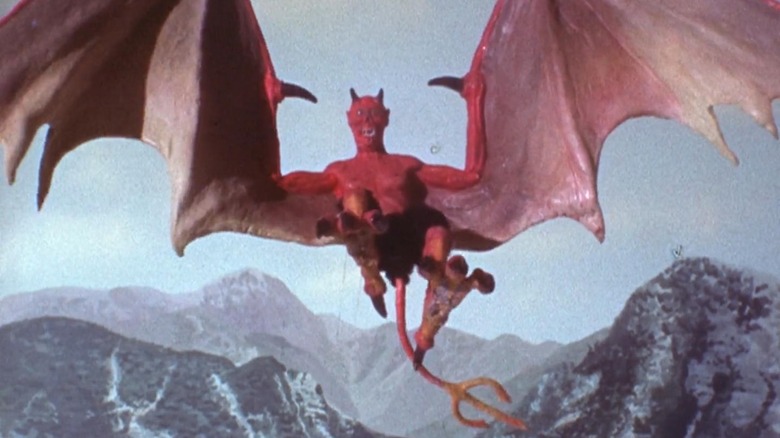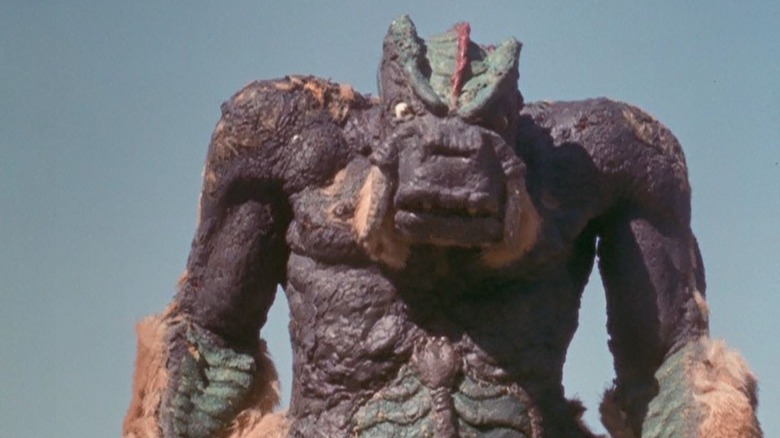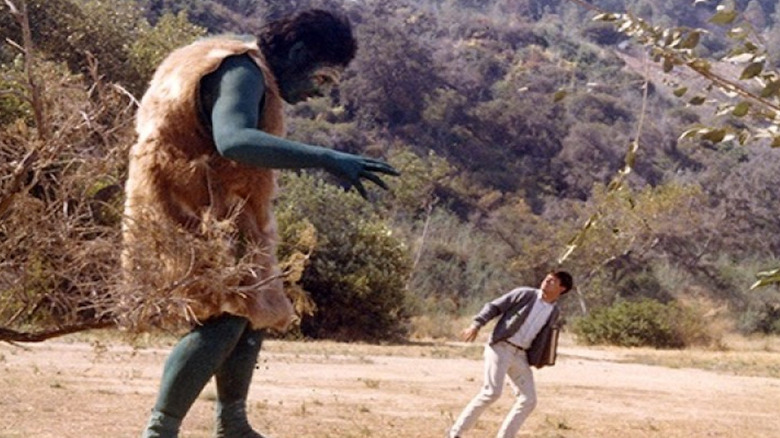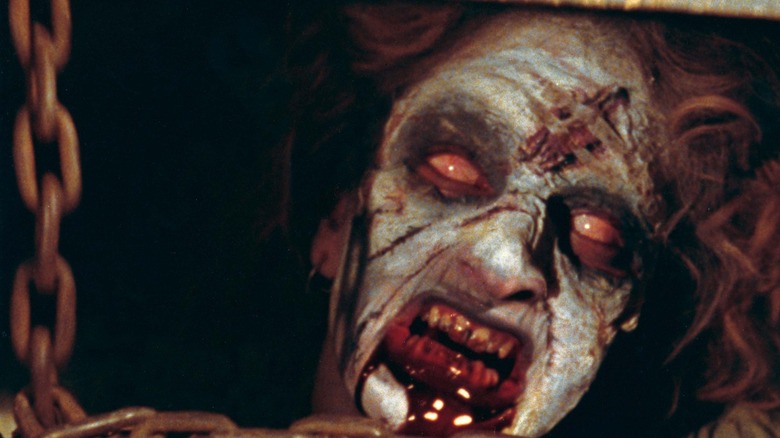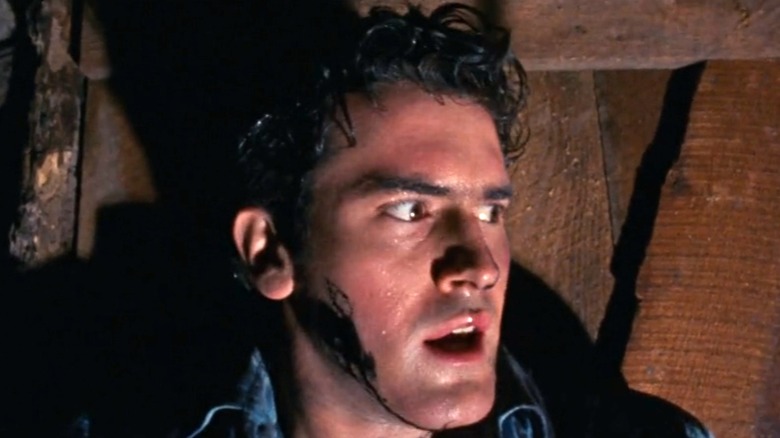The Low-Budget Horror Cult Classic That May Have Inspired Evil Dead
In the fall of 1979, Sam Raimi, Bruce Campbell, and the rest of the cast and crew arrived on location in the woods of Tennessee to make a movie called "The Evil Dead." It wasn't always called that; its original title was "The Book of the Dead," and there were more suggested titles along the way. Thankfully Raimi went for economy, and the title we know today matches the film: Concise, scary, and in-your-face.
It also wasn't the first time that Raimi and friends had embarked on such a project. A year earlier, the young filmmaker rustled up $1600 to make a 30-minute proof-of-concept called "Within the Woods" to showcase his team's talent and raise money for their first feature-length movie. It is only just about watchable, but it is fascinating to see some ideas and techniques that Raimi would later use taking shape in the trial run.
"Within the Woods" helped secure enough funding to make "The Evil Dead." Released in 1981 after the successes of "Halloween" and "Friday the 13th," it became a sleeper hit. At that stage, even Raimi himself probably never envisioned that his film would go on to become a cult horror franchise, with two sequels, a remake, a TV show, and a new generation of Deadite-bashing movies beginning with "Evil Dead Rise."
Raimi's film was incredibly influential, cementing the spooky cabin in the woods setting as a subgenre of its own and paving the way for "Cabin Fever," Tucker & Dale vs. Evil," and, er, "The Cabin in the Woods." As groundbreaking as "The Evil Dead" was, its concept wasn't totally original. 13 years before Raimi made "Within the Woods," another young filmmaker and his pals made "Equinox," an ultra-low budget horror movie with an uncannily similar premise.
So what happens in Equinox again?
"Equinox" opens with a young man, David (Edward Connell), frantically fleeing an unseen menace in the woods. Making it to the road, he is struck down by a car with no driver.
Exactly a year and one day later, a newspaper reporter visits the psychiatric ward to follow up on his previous story about the mysterious deaths of David's friends. David, now in a catatonic stupor, becomes violent when shown a photo of his old university professor, Dr. Watermann (Fritz Leiber).
The reporter listens to a tape of David's testimony from when he was first brought into the ward. In flashback, David tells how he received a phone call from Dr. Watermann, asking him to come urgently to his cabin in the mountains. Along for the ride was his best friend, Jim (Frank Bonner), Jim's girlfriend Vicki (Robin Christopher), and his blind date Susan (Barbara Hewitt).
They find Dr. Watermann's cabin destroyed and no sign of the professor. Exploring a nearby cave, a crazy old man gives them a strange book filled with arcane symbols and ominous illustrations. Helpfully, Dr. Watermann's notes are tucked inside, revealing how his experiments with the book unleashed demonic creatures, one of which trashed his shack.
Things get worse from there. The gang finds huge footprints in the sand outside the cave and spots a castle that appears and disappears randomly; Dr. Watermann dies after snatching the book from David, only for his body to vanish; and they encounter Asmodeus (Jack Woods), a creepy forest ranger with very suspicious eyebrows. For a finale, the kids witness the true power of the book. They're attacked by a huge gorilla-like creature and a giant caveman before Asmodeus reveals his true nature and turns into a winged demon. Running for their lives, David is the only survivor. Or is he?
Equinox was a labor of love for its creators
"Equinox" was the pet project of young filmmaker and producer Dennis Muren, who got together with writer Mark McGee and stop-motion animator David Allen to make their own monster movie. Muren would go on to have a hugely successful career in special effects, winning eight Oscars for his work on movies like "The Empire Strikes Back," The Abyss," and "Jurassic Park."
With that kind of nascent talent behind the project, it's no surprise that the special effects are what really make "Equinox" worth watching. The stop-motion creatures wouldn't look out of place in a Ray Harryhausen movie, which is incredible considering it was made by a group of teenagers on a tiny budget. The rest of the film is fun but unremarkable, with pleasant performances and a cheerful can-do spirit. Without the benefit of lighting, Muren and friends shot during the day, giving the movie a sunny Californian vibe like the Beach Boys took a wrong turn and wound up in a horror flick.
Muren's movie was shot over two years and then lay dormant until it was picked up by Jack H. Harris, the producer best known for "The Blob." He hired editor Jack Woods to film extra footage with the original cast, re-edit, and pad it out to feature length for a theatrical release in 1970. The newer footage mostly blends in, although the length of time between the original 1965 shoot and the extra scenes results in the actors visibly aging and de-aging before your eyes.
The similarities between "Equinox" and "The Evil Dead" don't stop at the storyline and subject matter. Although Raimi's film cost considerably more, it was still a low-budget project that needed plenty of hands-on ingenuity. One that was made in far less sun-kissed circumstances.
The Evil Dead was a tough shoot for cast and crew
"The Evil Dead" eventually cost $375,000, which sounds like a fortune compared to what Sam Raimi originally had to work with for his prototype. Even so, it was still an exercise in DIY-style filmmaking that put the cast and crew through a miserable 12-week shoot as winter set in. As Raimi told IGN:
"There was no running water, and it was in the 20s and 30s — we didn't have any winter wear. It was freezing. When you're in that cold for 16 hours, you start to — I started to die. There was no food, and everything was covered in Karo syrup in that temperature... The only water we had was in a hot water heater so you could make instant coffee. Boiling water over your hands from the tap; that's how you'd wash them, to load the film into the camera."
One of the great things about "The Evil Dead" is that you can almost see the filmmaker's fingerprints. When you feel that human touch and the passion that went into it, it's easier to overlook the moments when the budget restrictions poke through. Raimi's directorial style stands out, typified by those signature crash zooms and prowling P.O.V shots representing the evil force crashing through the woods. Those moments still look really accomplished, achieved by strapping a camera to a length of timber and running with it through the woods. The effect is so good that Raimi even snuck a slicker version into his much higher budget "Spider-Man 2." As for the gloopy makeup effects, the man responsible was Tom Sullivan, who also worked on "Within the Woods" and credits "Equinox" with influencing his career.
Did Equinox influence The Evil Dead in any way?
Given the close similarities in the storyline and subject matter, it would seem surprising if "Equinox" hadn't had some influence on "The Evil Dead." However, Sam Raimi has cited "The Night of the Living Dead" and "The Texas Chainsaw Massacre" as major inspirations instead. This makes sense, as they were also groundbreaking low-budget horrors that were largely set in a claustrophobic single location.
"Equinox" was promoted by influential editor Forrest J. Ackerman in "Famous Monsters of Filmland" magazine, bringing it to the attention of a new generation of creature feature lovers including Tom Sullivan, who oversaw the makeup effects in "Within the Woods" and "The Evil Dead." He acknowledged the film had a big impact on his career (via Criterion):
"I had seen 'Equinox' at least twice in drive-ins before making 'The Evil Dead.' I don't recall having discussed it with Sam Raimi, but the similarities are remarkable. I think they come from the low-budget nature of both films. That is, a few characters, an isolated, inexpensive location, and ambitious special effects. All in all, 'Equinox' did inspire me to continue my goal of making movies. 'If they can do it...'"
I'm not about to accuse Raimi of ripping off "Equinox" but, as they say, there is no such thing as an original idea. Whether Sullivan remembers it or not, it seems unlikely to me that the film never came up when talking about the storyline for "The Evil Dead." After all, the source of evil changed from a desecrated burial ground in "Within the Woods" to a necromantic book unleashing demons on a group of teens. Whether it had an influence or not, the charming earlier film makes a fun port of call for "Evil Dead" fans eager to check out the connections.
